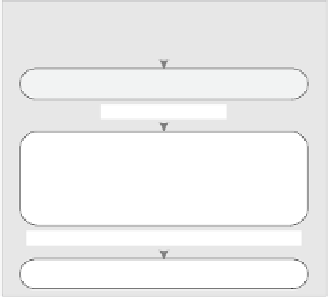Information Technology Reference
In-Depth Information
Modeling Languages Integration Process
Step 1:
Definition of Modeling Language Metamodels
instanceOf
InstanceOf
Source
Modeling
Language
X
Target
Modeling
Language
Y
Step 2:
Definition of Integration Metamodel
Integration Metamodel
Step 3:
Automatic UML Profile Generation
UML Profile
instanceOf
InstanceOf
Metamodel Comparison
Integration Metamodel Transformation
Models
X
Models
Y
Integration Metamodel + Interchange Information
Step 4:
Generation of Model Transformation Rules
Model X
Model Y
Fig. 3
Integration process application schema
Even though the UML profiles can be applied over any MOF metamodel, we
only use the essential subset of the constructs that are defined in MOF for the speci-
fication of the metamodels of the modeling languages to be integrated. This subset,
which is known as EMOF (Essential MOF), is defined inside of the MOF specifica-
tion. The decision to use EMOF (instead of complete MOF) is due to the closeness
that exists between EMOF metamodeling capabilities and UML profile extension
capabilities. This facilitates the generation of UML profile extensions to integrate
the particular metamodeling information of a source EMOF metamodel into a target
EMOF metamodel [
14]
.
The integration process is comprised by the following steps:
Step 1. Definition of Modeling Languages Metamodels.
This step corresponds
to the specification of the EMOF-based metamodels
[30]
that are related to
good set of guidelines for the definition of these metamodels.
Step 2. Definition of the Integration Metamodel
. The Integration Metamodel
is the solution defined in [
14]
to automatically generate metamodel exten-
sions for the integration of two modeling languages. This is an EMOF-based
metamodel that is generated from the metamodel of the source modeling
language, and its definition includes the mapping information to identify
the equivalences between the source and target modeling languages. The
Integration Metamodel specification and the systematic approach proposed
for its definition are presented in [
14]
.
Step 3. Automatic UML Profile Generation
. This corresponds to the mechanism
implemented for the automatic generation of modeling languages extensions,
which has been presented in [
12]
. This is a two-step process that not only
automatically generates a UML profile from an Integration Metamodel, but
also generates mapping information for the interchange of models defined
with the integrated modeling languages
[10]
. The two steps of the UML
profile generation are:










Search WWH ::

Custom Search